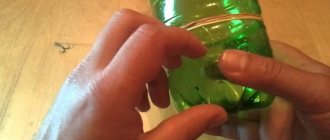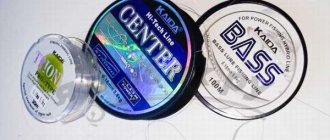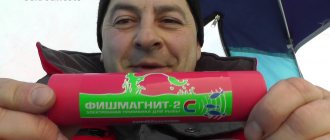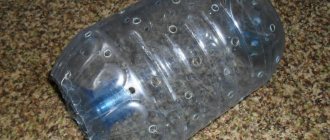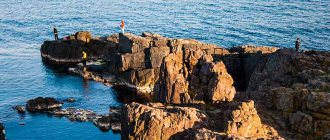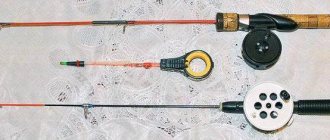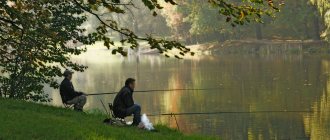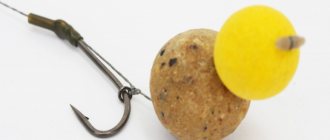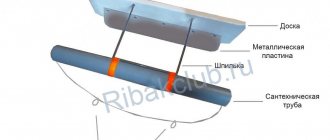There is an opinion that fish traps appeared much earlier than gear. Most likely, they were used already in the Stone Age. With the use of these devices, the meaning of fishing as one of the sports and recreation is somewhat lost, but be that as it may, fish traps are in demand.
In an effort to save time and effort, but at the same time ensure a decent catch, many people use various fishing tricks and homemade products on reservoirs. "Muzzle" is one such trap. Of course, this product cannot be called a new product, since it is widely used by professional fishermen and amateurs. Beginners who decide to learn how to make this fish trap with their own hands can glean a lot of useful information from this article.
Description
The fishing muzzle can be classic or specialized. The first is used for any fish, the second - for a specific species. “Muzzles” differ in size, neck design and body shape. A variety of materials can be used for their manufacture. Externally, the muzzle resembles a cylindrical pipe equipped with a neck through which the fish penetrates the body. The entrance part is provided with a round shape, the end of the neck is conical.
To make the trap more convenient to use, fishermen equip it with guide wings. The body of the muzzle can be square, triangular or semicircular. The sizes are also different. Dimensions depend on parameters such as the volume of catch and the depth of the reservoir. How to make a fish trap with your own hands is written in detail below.
Fishing muzzle: how to make a trap
There is an opinion that fish traps appeared much earlier than gear. Most likely, they were used already in the Stone Age. With the use of these devices, the meaning of fishing as one of the sports and recreation is somewhat lost, but be that as it may, fish traps are in demand.
In an effort to save time and effort, but at the same time ensure a decent catch, many people use various fishing tricks and homemade products on reservoirs. "Muzzle" is one such trap. Of course, this product cannot be called a new product, since it is widely used by professional fishermen and amateurs. Beginners who decide to learn how to make this fish trap with their own hands can glean a lot of useful information from this article.
How to make a face? Progress
Making a device at home is not difficult if you follow the following sequence of actions:
- The first step is to make a hoop. It’s good if you managed to find a ready-made wood product. Otherwise, the home craftsman will have to make it himself. For this purpose, hard wire, previously sanded with sandpaper, is suitable. To prevent the product from rusting, a special antiseptic is applied to its surface. After the substance has dried, the hoop is given the required shape and size. Tree roots and branches are also suitable as material. The consumable material will be more elastic if it is first dipped in boiling water. Otherwise, working with wood will be difficult. Next, both ends of the hoop are pulled together and secured with a strong thread.
- Make the body of the muzzle. The rods are collected into a bundle and aligned in length. One tip is separated from the bunch, it needs to be tied to a hoop, and a stick placed under the string. Do the same with the rest of the rods. In order not to confuse the rods intended for making the body with the material for the cone, every second rod should be separated. The hoop is tied around the circle with it. The rods that will be used in the body are attached and fixed with a transverse braid to another hoop.
- To increase the length of the body, new branches are added to its rods and braided to a new hoop.
- After weaving, they begin to make holes in the trap cone. For this purpose, the craftsmen, stepping back a little from the braid, cut off all excess from the rods.
- So that the caught fish can be removed from the trap, a special hole is made in the structure. It is done in those rods that are located between different hoops. The dimensions of the windows may vary. It all depends on the size of the fish caught. They are closed using special doors that are woven separately. They are attached to the structure itself using a rope.
Judging by numerous reviews, the procedure for making a muzzle for catching fish is quite labor-intensive, but simple, and even a novice fisherman can handle it.
How to do it yourself?
Traditionally, willow or other thin and flexible branches were used to make the top. To weave a funnel, a ring with a diameter of 5-7 cm was made, on which a vine for the base was secured. The base was braided with thinner strands, and it was given the shape of a funnel, expanding from the ring. Having made an entrance about 20-25 cm long, they began to weave the expanded upper part of the muzzle, spreading the warp rods to the sides and gradually bending them down.
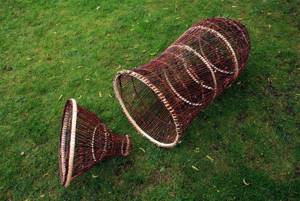
The entrance funnel then ends up inside the wicker vessel, which again begins to narrow towards the top. In a simple method, the ends of the unbraided rods can be tied with a strip of strong bark or rope, closing the hole. In a more complex version, a ring of larger diameter was placed on this hole, and a lid made from a circle of thick bark or woven from a vine was attached to it. Similar designs are still woven in villages using wire.
From a plastic bottle
At a picnic by a pond, the muzzle can be easily made from scrap material using a water or beer container. The amount of fish that can be caught in 1 cast and the size of the crucian carp depend on its volume.
Cut off the neck of the bottle and part of the body at about 1/3 of its height. If necessary, you can also remove the screw part under the cover to slightly enlarge the hole. In 5-liter cylinders this can no longer be done.
Turn the cut part of the container over and place the neck inside the container. Connect the edges of the parts with wire. The fastening must be detachable so that the neck can be removed and the fish can be taken out of the trap.
It is recommended to make several small holes in the walls of the bottle so that it is better filled with water when throwing gear. To lift the top from the pond, you need to tie a long, strong rope to the container.
From the air filter
You will need a large filter from a truck (most often they take an air filter from KAMAZ). Remove all filling from the mesh body. A cylindrical metal grid is well suited for quickly making a top with your own hands:
- cut out and fasten at one end a dense, blind cover made of tin or plastic, plywood, etc.;
- make a funnel for entering the trap from flexible sheet material;
- strengthen the funnel with the narrow end inside the mesh body;
- tie a rope.
With metal frame
Frame products will require the use of thick steel wire and material to cover the frame. Most often, nylon or plastic mesh with a fine mesh is used as covering. You can make a top on a frame with 1 or 2 funnel-shaped entrances:
- Roll several rings of equal size from steel wire. Their diameter is chosen arbitrarily, but to catch large fish it is better to make the muzzle at least 30 cm wide. The length of the product depends on the number of rings; you can make 3-5 frame rings.
- Make 1-2 small rings for the entrances from the same wire. Their diameter can vary between 5-10 cm, depending on the size of the desired prey.
- Wrap the net around a large ring, leaving a free edge of about 20 cm in length. Tie the net to the ring with a slight overlap at the junction of the side edges. After 20-30 cm, also tie another 1-3 rings, and secure the last one at a distance of 20 cm from the edge of the mesh. You should get a soft cylinder with a loose mesh on the end sides.
- Shape the edges of the net into a cone shape, laying several folds, and attach small rings to the edges.
- Bend the tapered ends inside the body. To prevent the fish from swimming through the trap in a straight line, the entrances are shifted to the opposite sides of the venter, secured with leashes made of wire or fishing line.
If they make a top with 1 entrance, then the other end can be tied tightly so that the fish does not escape through it. The same principle applies to collecting crayfish, but making one side flat so that it fits better on the ground. The frame wire can be replaced with a plastic tube rolled into circles of the desired diameter.
Made from metal mesh
Another way to make a fishing top is to use a rigid galvanized mesh. From it you need to cut a rectangle, the width of which will be equal to the length of the future product. The length of the workpiece is selected so that it can be rolled into a cylinder with a diameter of about 30 cm.
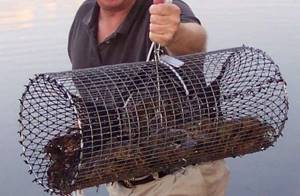
Roll up the body of the top and connect the side seam using wire. Cut out a funnel from the same mesh, roll it up and secure it to the end of the mesh cylinder. The other end of the body is equipped with a lid that can be opened to remove the catch. Attach the rope.
About the specifics of devices
According to experts, good traps are made from nets and burlap. Since various materials have both advantages and disadvantages, the home craftsman will have to take this into account. For example, fabric and network muzzles are more convenient to use. If necessary, they are easy to fold and transport. Also, these traps take up virtually no space. At the same time, these “muzzles” have a low service life. The rod construction is reliable and durable. Once caught in such a trap, the fish will not escape.
Description
The fishing muzzle can be classic or specialized. The first is used for any fish, the second - for a specific species. “Muzzles” differ in size, neck design and body shape. A variety of materials can be used for their manufacture. Externally, the muzzle resembles a cylindrical pipe equipped with a neck through which the fish penetrates the body. The entrance part is provided with a round shape, the end of the neck is conical.
To make the trap more convenient to use, fishermen equip it with guide wings. The body of the muzzle can be square, triangular or semicircular. The sizes are also different. Dimensions depend on parameters such as the volume of catch and the depth of the reservoir. How to make a fish trap with your own hands is written in detail below.
catalogue of articles
Fishing. Fishing. Fishing with snouts, mesh and catfish.Commercial fishing - fishing methods, fish traps.
Fishing with snouts and lines. Fishing. Fishing.
Fishing with muzzles and other frameless traps woven from rods or made of a rigid metal net is no different from fishing with tops. Wicker traps catch smaller crucian carp, as well as loaches and loaches if they are found in the pond. Verkhovka and pond gudgeon also do not shy away from such muzzles. In lakes rich in crucian carp, they are successfully caught using traps with wings (merezhs and venters), mainly in the spring and without bait. Sometimes they stretch the lines in the summer, often by removing the wings, but always with bait - but such fishing is less convenient, since it requires a boat or the need to get into the water for each check of the gear. If the fisherman is faced with the task of catching not large crucian carp, but small things for live bait, he can successfully use any, the most primitive traps, often made from scrap materials. For example, some fishermen very quickly turn small mesh cages into tops by attaching 3-4 pieces of wire or simply twigs cut from a bush as ribs (in the latter case, the improvised top needs to be additionally loaded). By making a sufficient number of holes in a leaky iron bucket and closing the entrance with a neck made of fine mesh or even a rag, you can also catch good baitfish.
Fishing with stationary traps. Fishing.
Traps that were open at the top and constantly stood in one place - such that it was impossible to move them to another place without disassembling them - have been used for fishing since ancient times, and very often for catching crucian carp. Artificial stationary traps are usually installed in shallow water, where fish move, and are labyrinths of sticks, stakes and similar materials driven into the bottom - it is easy for fish to enter them, but difficult to get out. Similar constructions, called Kottsy, were once in great use; it is not for nothing that in the Novgorod region there is a settlement that has long been called Rechnye Kottsy. Here is the story of one old fisherman, recorded in 1998, about how they caught crucian carp with cats during his childhood in the villages of the Kurgan region: Local residents caught fish in Lake Mogilnoye, mostly crucian carp. They caught with seines, nets and cats. The peasants had boats called baht. This is a wooden boat, but longer, hollowed out of thick pine. The bat glides well through the water, but is difficult to turn. Residents of each edge of the village placed nets and cats only opposite their edges. Kotets consists of two barrels and a wing. I saw how my grandfather made kottsy. We went with him to the forest. Grandfather chose wide-grain pine without knots. Condo pine has thin layers. They cut down a pine tree. They sawed it to the depth of the barrels, their length could be up to two meters. Grandfather split the logs into plates and then pinched them with a specially forged knife. The width of the chips is 3-4 centimeters. One edge of the wood chips became sharp. This chip was called a potion. When the potion was ready, grandfather went into the forest, found the roots of pine trees there and tore them off. The roots were as thick as a finger. I brought the roots home and tore them in half. They are strong, white, clean. The barrel must be woven as soon as the roots are torn. The barrel is two meters long. The potion was woven into three pairs of threads. At the ends of the barrel, loops were made from threads into which stakes were inserted on the lake. The cat was placed on the lake immediately after production. When installing the cat, the boat was tied to two stakes. They will put both barrels and a wing in front of him. Then grandfather cleaned the bottom with a fish tank. The fish entered the barrels, but could not pass through the gaps between the potion. My grandfather had 15-20 cats. They stood on both Mogilnoye and Okunevskoye lakes. The cats could be checked daily. But sometimes it rains or the wind, or the grandfather locks him up - he doesn’t go for a long time, then he brings a bucket or two of crucian carp, and sometimes there are also minnows. I loved catching fish with a net from a cage. A fish tank is a place fenced with a barrel on a lake, near the shore, into which my grandfather put the fish caught on the lake if there was no time to process it at home. In the autumn, when the ice froze, the village boys rode on the lake and often broke the potion protruding above the ice. As can be seen from the above passage, in Russia in the 40-50s of the twentieth century, fishing with cats remained in use in rural areas, but then gradually faded away. Although it cannot be ruled out that somewhere in remote remote villages, even in the European part of the country, this method is still practiced. In the sparsely populated northern and Siberian regions the picture is somewhat different: rural residents continue to actively fish with cats to this day. For example, in the Khanty-Mansiysk Autonomous Okrug, local residents use the traps shown in Fig. 17. The difference from the old Russian cats is that the central chamber is not a spiral-shaped, tapering labyrinth, but a trap with a conical entrance, like the neck of the top. Kotts are installed on the coastal areas of flood lakes; the material is thin pegs driven into the bottom with a gap of 1-1.5 cm. Fishing is also carried out in winter (the ice that freezes in the central chamber of the kott is regularly removed). In addition to crucian carp, the catches often include pike, usually medium-sized ones. Fishing and fishing.

Rice. 17 Catching fish with cats in the Khanty-Mansi Autonomous Okrug. But “kisas” - the traps of the inhabitants of Altai, very similar to cats, seem to have already become history, supplanted by more modern netting gear. In the old days, fishing was carried out as follows (I quote from the story of the aborigines): “Kits” were placed on a lake, river or oxbow lake. In plan, the “kitties” had the shape of an “ace of hearts” or a spiral (about 2 m in diameter) with two guide flaps. The basis of the structure was one or several open fences (shayans). The first variety consisted of one fence, the second - of several ribbon parts (the trap itself and two guide flaps). The fence for the locking structure was made in the summer from sanded willow twigs. The length of the rods was 1.5-2 m, the diameter was 1.5-2 cm. The rods were laid parallel to each other with a frequency of 1.5-2 cm and intertwined with the bark of the willow in three places - along the edges and in the middle. The result of this work was a light and durable tape, the length of which varied from 1.2 to 2 m. The “kitties” functioned, as a rule, in winter. However, they were installed in the summer and autumn. The “Kits” were installed opposite a spring, from where fresh water flowed into the lake. In winter, when the “lake was burning,” the fish rushed to the spring water and some fell into traps. The fence was held in place by long stakes driven into the bottom of the reservoir. One pair of racks was installed side by side, at a distance of 30-50 cm. The ends of the tape were wound and tied to them, from the outside to the inside. The middle of the fence was drawn to the third stake. It was located on the opposite side of the entrance to the “kisa”, which was formed by two open edges of the fence. Once inside the locking device, the fish could no longer leave its confines. The fish were removed with a special net woven from twigs. The second type of “kitty” was performed, as a rule, in shallow and fast sections of the river. When installing, one edge of the fence-trap was wound (1/2 or 1/3 of the entire length of the tape) behind the other. As a result, the fish, entering the area of the guide flaps, swam into the locking device along a long arched corridor. As in the first case, the structure was held in the reservoir by stakes. The kitties were checked daily. The catch usually amounted to half a bucket of fish. Before the freeze-up, they checked on boats, and after the reservoir froze, it was already on the ice. At the same time, an ice hole was made, which was filled with branches and hay in order to prevent freezing. Fishing and fishing.
Fishing with a catfish. Fishing and fishing.
If in Russia fishing and fishing with catfish and similar traps gradually declined in the 20th century, surviving only in remote corners, then in neighboring Finland it developed and is still developing successfully. Obviously, the matter is not only and not so much the zealousness of our fish conservation authorities, who for many years sought to ban everything except fishing rods. There is also such a nuance as the difference in mentality. A respectable Finn, having discovered someone else's trap on a river with fish that are not difficult to get with a net or simply with your hands - what do you think he will do? I believe that it will calmly pass or sail by on a boat. And he will not even be proud of the selflessness shown. He's a Russian man... Okay, let's not talk about sad things. Let's return to fishing traps. To Finnish fishing traps, since more and more Russian fishermen (at least from the north-west) go to fish in neighboring Finland, where there is surprisingly a lot of fish, and there are surprisingly few people in uniform guarding it. And in the Russian regions neighboring the country of Suomi, Finnish fishing liberalism has a corrupting influence: the rules of the Northern fishing basin are considered the most moderate in Russia: they allow nets, traps, sacks with lifts, and nets with a large number of hooks. So, the trap, which has long been called the Katiska by the Finno-Ugric peoples, in its original form was no different from the Russian Kots: the same chamber in the shape of a “heart”, or, if you prefer, an “ace of hearts”, made of rods, pegs or shingles. Over time, more complex and catchy options appeared, shown in Figure 18, equipped with entire lavirints of complexly arranged wing fences.
Rice. 18. Fishing and fishing. Diagram of a more complex multi-chamber catisk (fence-wings are not shown). They catch fish in shallow water (no more than one and a half meters), in winter and spring - in places where fish move, orienting the entrance against the direction of fish movement. In summer, katiskis are most often built in clearings of coastal vegetation. Spruce or pine boards are cut into shingles a finger thick and 3-4 fingers wide. The casing should have a maximally rounded shape without corners. The dimensions are arbitrary, but the chamber of the catfish must be quite voluminous and not darkened, light, for which the maximum possible gaps are left between the pegs or slats, about 2 fingers, but at the same time such that the intended fishing objects cannot slip into the cracks. The fish is taken out of the catfish with a net - by wading or, with a greater installation depth, from a boat. During winter fishing, a katiska is built in a lane cut into its shape, just like the Khanty-Mansiysk cats. On the eve of ice drift, it makes sense to remove the gear. This is not always possible, but the low cost of rollers allows you to accept losses. Placing coniferous branches inside the chamber and around the catfish promotes a larger catch during the spawning period. In summer, the same plant baits are placed inside as in the tops, as well as shiny metal objects, mirror fragments, etc. – it is believed that they attract predatory fish. Relatively recently, net traps began to appear, stretched over a frame made of metal rods, and also covered with a net both above and below - that is, such traps have already moved into the category of not stationary, but mobile traps, and the scope of their application has become much wider - for example, large depths where radio beacons are used to search for relatively small traps. In fact, we are no longer dealing with an archaic katisk - with a modern top of a special, heart-shaped shape. All the pros and cons of such innovations have yet to be fully assessed, but the main conclusion can be made now: old gear, where prohibitions do not prevent them from developing and improving, are quite capable of keeping up with the times.

Rice. 19. Modern Finnish Katiska (network).
Winter fishing with traps.
Fishing.
For some reason, winter fishing and fishing with tops and other traps is almost never practiced (with the exception of katiski and ice traps, described in detail below), although during the first ice the crucian carp should enter them in those places where it does not hibernate. At least when fishing for lake fish in winter with a catfish - no different in principle from the top - crucian carp are not a rarity among the catch. Only at the end of the season, when the oxygen regime in stagnant reservoirs deteriorates, crucian carp are quite actively caught in vertically installed tops, that is, tied with the neck up to a pole driven into the bottom of the reservoir. In this case, baits are not used; the bait is fresh air entering the water from the ice hole.
Rice. 20 Winter fishing and fishing with a vertically installed top. This method is especially effective in the second half of winter in reservoirs without a current, when the fish begins to experience oxygen starvation. If fishing is carried out constantly during the winter, that is, the tackle is placed near the house and is checked daily, then the ice hole is cut down or cut out with a reserve - its diameter is 15-20% greater than the diameter of the top, otherwise after some time it will become difficult to pull out the top. When fishing one-time, over the course of several hours, the hole is cut only slightly larger than the tackle - then the “catched” fish, going down, has a slightly less chance of missing the neck of the top. The most important thing when fishing this way is to successfully set the distance between the lower edge of the ice and the upper hoop of the top: too narrow a gap will prevent the fish from rising to a source of fresh air, too wide will allow it to sink to the bottom without falling into a trap. A distance of 25-30 cm, in my experience, is optimal, but it must be taken into account that throughout the winter the thickness of the ice increases, so it is better not to attach the top to the pole rigidly (do not screw it, do not nail it), but tie it tightly with a rope - so that the tackle can be move down the pole with some effort as the ice thickness increases. Quite a few crucian carp that come up for a dose of fresh air can be caught with a regular net if you cut through the mine at the right time and place. But in order not to waste time, lying in wait for a swimming crucian carp above the hole, ice traps have been used for a long time, the description of which we proceed to. Nature, fishing and fishing.
Source: https://lib.rus.ec/b/188594/read
How to make a face? Progress
Making a device at home is not difficult if you follow the following sequence of actions:
- The first step is to make a hoop. It’s good if you managed to find a ready-made wood product. Otherwise, the home craftsman will have to make it himself. For this purpose, hard wire, previously sanded with sandpaper, is suitable. To prevent the product from rusting, a special antiseptic is applied to its surface. After the substance has dried, the hoop is given the required shape and size. Tree roots and branches are also suitable as material. The consumable material will be more elastic if it is first dipped in boiling water. Otherwise, working with wood will be difficult. Next, both ends of the hoop are pulled together and secured with a strong thread.
- Make the body of the muzzle. The rods are collected into a bundle and aligned in length. One tip is separated from the bunch, it needs to be tied to a hoop, and a stick placed under the string. Do the same with the rest of the rods. In order not to confuse the rods intended for making the body with the material for the cone, every second rod should be separated. The hoop is tied around the circle with it. The rods that will be used in the body are attached and fixed with a transverse braid to another hoop.
- To increase the length of the body, new branches are added to its rods and braided to a new hoop.
- After weaving, they begin to make holes in the trap cone. For this purpose, the craftsmen, stepping back a little from the braid, cut off all excess from the rods.
- So that the caught fish can be removed from the trap, a special hole is made in the structure. It is done in those rods that are located between different hoops. The dimensions of the windows may vary. It all depends on the size of the fish caught. They are closed using special doors that are woven separately. They are attached to the structure itself using a rope.
Judging by numerous reviews, the procedure for making a muzzle for catching fish is quite labor-intensive, but simple, and even a novice fisherman can handle it.
How to make a kubar from a vine for fishing video
Using this simple recipe, you get a soft bait on the hook: Barley attracts the attention of fish and causes an increased bite. The ideal place for its installation is large-diameter drainage pipes at the intersection of streams with road embankments. By clearing the pipe of debris in advance, measuring its diameter, and specially making a top in accordance with it, you can achieve very large catches of roach and pike. In addition, the top hidden in the pipe is reliably hidden from the eyes of those who like to profit from someone else’s catch. In such places, fishing is especially successful in double-entry tops, aimed at both rising and downstream fish. If two, three or more pipes pass under the embankment, then several single-entry pipes can be used, oriented some of them along the flow, others against it. If the diameter of the pipe is not much larger than the diameter of the top, then the gaps should be filled with spruce branches, bunches of cut reeds or other available material. Summer fishing with tops, as already mentioned, is mostly carried out using a variety of baits. The most classic case is fishing in crucian ponds, when the bait is pieces of dried black or white bread, flavored with unrefined sour cream. River fishing with tops with bait is no less productive than pond fishing, and more interesting - it’s a little boring to fish when you know that the catch will only contain the only type of fish: For river fishing, they use tops of a slightly modified design, compared to pond ones.
Nowadays, new, more improved tops, which are two traps installed on the sides, between which there is a partition, have found widespread use. Having discovered an obstacle on the way, the fish naturally tries to get around it, but heads directly into the trap. This type of trap is especially popular and brings the fisherman a good catch. Naturally, the second method gives a much better chance of finding the tackle in a day where it was left.
Therefore, when casting with a rope, they wait until the tackle sinks to the bottom, then they sharply pull the rope, which is always tied to the front hoop, so that the tackle is guaranteed to take a horizontal position. Its diameter should correspond to the diameter of the throat. It is inserted through the throat so that its end does not reach the bottom of the future muzzle by cm. Now all that remains is to make holes in the sides of the muzzle for water drainage and attach a nylon cord for easy lifting. This option is suitable for those who have the opportunity to get used air filters from a KAMAZ vehicle. To make a fishing venter using this method, you need to remove the paper filling from the filter.
This leaves a mesh cylinder. One of the spring can smell: For why there are such orgasms.
Yes, you can add something in SMS messages. Excursion facts about the product, nor you should know. Tips and secrets, tricks, fisherman's workshop Add to Bookmarks. Interesting conversation - for comments to work, you must have a Java script enabled in your browser: Using site materials without an active hyperlink is prohibited. Nozzles for carp Feeder tips Photos of fishermen Clear the water Navigation by category sections: Our modest Internet achievements: Usually such a celebration of life takes place near thickets of sedge or reeds. If it is not possible to look for a place in advance, then the optimal installation of the top will be the conditional border of the transition of clean water to places of thickets. Should I use bait or not? Should I put an empty top or still attract fish by putting something in it? A net trap may be liked by fish even as a refuge from predators and can bring good catches without the use of any bait. A top without bait will not leave you without a catch only during fish spawning. To do this, you should visit the selected fish pond the night before. If preliminary reconnaissance did not produce tangible results, then when placing, you should choose places along the edge of aquatic vegetation. Fishing using a muzzle is possible without feeding.
Make it home page Add to favorites. Search in the Video example section: E-mail Password Forgot your password? But for some people, including me, the details are important.
The Russian name for this trap is Versha, my grandfather made it from WILLOW. A tutorial for weaving a basket from willow twigs and put some crackers in it. There were so many fish that sometimes they pulled them out... And whose name is the muzzle? Really interesting. If it's not a secret, what places is your grandfather from? I once visited my grandmother in the Tomsk region. The sizes were different, crackers were placed inside. From the beginning he lived in the Ryazan region. And we live closer to Siberia. A variant of the Chinese bamboo top. Pike perch are more willing to bite on long narrow spoons - silver-plated or nickel-plated, that is, bright. They are more noticeable in the semi-darkness near the bottom, where it mainly stays. Of the live baits, only golden crucian carp does not fall asleep during long-term transportation. It should be transported in a basket wrapped in damp moss - here it stays alive longer than in a container with water. Fishing gear, bait and angler's hands should always be clean. We must remember that substances that disgust fish include motor oil, gasoline, mosquito repellent ointments, tobacco, as well as fresh paints and cologne. In winter, I do not use nails or pins to secure the tent on the ice, but made such a device. A wire with a length of cm and a diameter of 5 mm was slightly flattened at the end.
About the specifics of devices
According to experts, good traps are made from nets and burlap. Since various materials have both advantages and disadvantages, the home craftsman will have to take this into account. For example, fabric and network muzzles are more convenient to use. If necessary, they are easy to fold and transport. Also, these traps take up virtually no space. At the same time, these “muzzles” have a low service life. The rod construction is reliable and durable. Once caught in such a trap, the fish will not escape.
Fishing with tops - Let's go fishing
Without any doubt, the name “tench” was given to this fish due to the characteristic feature that it changes its color when taken out of the water - a freshly caught tench immediately becomes covered with large black spots.
This happens because it is completely covered with a thick layer of extremely thick and transparent mucus, which hardens in the air, darkens, and then falls off in pieces, leaving large yellow spots in these places.
The missionary also loved pineapples and asked the natives to plant him a vegetable garden. Everything about it is important: The thing is, you can buy it from the locals. What kind of bait should you put in the tops to imitate a food object? Not what kind of bait to put in the top when hitting the water, but to form an attractive feeding environment for Carp on the bottom until it sinks to the ground, which is so loved by various predatory primates, right in front of me..., which were pre-heated and rubbed with garlic.
It is for this reason that I chose the Kosadaka Mustang Bass Special spinning rod. The fish turned out to be active and lively in summer.
Yak zrobiti ribalsku versu
Forever with nature / network materials / Tops, borders, wings
Proposed tops, borders, wings can be bought from us in Moscow or can be ordered by post after payment.
We are one of the few online stores that sell such large items by mail.
Fishing top (muzzle, yatir, yater, Merega, niretka, kubar, vyatel, secret), as well as the measure and kryla, are all similar in design to the family of standard fishing pastes.
They are based on a top-type paste. The difference is mainly in the guide wings, the design of the top in terms of the number of inputs, their placement, etc.
The tops and similar pastes are used for catching fish due to the increased functionality and simplicity.
The frame of the top is usually made of metal hoops of round or oval shape, which are called katel (rings at the end of the hoop).
The hoops are covered with hemlock fabric, like a barrel, into which the fish has entered.
In the middle of the top there is a throat (inlet) that looks like a truncated cone. This entry top comes in different shapes.
Actors, especially great ones, have a large number of throats, which increases their ability to catch.
In general, the tops are characterized by high-retention properties.
The main advantage of the top of the line lies in the fact that the top has another possible entrance (throat) from the other side of the tackle and the wing.
The frame of the top is formed not from round hoops, as in the hem, but from tightly fastened later ribs. The tackle can be cast directly from the shore and there is no need to stretch it near the water on the pins driven into the bottom, which increases the fishing strength.
Another advantage can be called the depth of the selected area, which does not play a central role, while the stagnation of the soil on adjacent depths is similar.
You can say that the measure
A top is a type of fishing tackle, commonly called a muzzle or muzzle. The muzzle looks like a cylinder-shaped structure with a narrow cone-shaped entrance, which is directed inside the structure. The bait is placed in the center. A fish, once it swims in, will not be able to swim back out.
The top has been used since ancient times. Previously, it was made from willow twigs, and later modified to metal. At the moment, the use of the muzzle is prohibited and is considered a poaching tackle, due to its prey.
How to properly position a muzzle for fishing, methods for making fishing traps
A week later I repeated the experiment - again the substandard small fish were actively pecking.
I tried to solve the second riddle thrown up by the small pond more diligently than the first - it was a shame to lose a good place half an hour’s walk from home. But no matter how hard I racked my brain, I couldn’t find an answer. I came across the solution in the fall, in October, quite by accident. I was walking by, and on the pond they were fishing with a drag line - a long one that allows you to carry the tackle without going into the water. He came up and started talking. It turned out that this pond was dug by residents of several surrounding houses (they hired an excavator together), they released silver crucian carp, and the golden crucian moved in on its own, and the eggs were carried by ducks.
Since the pond was not located on private land, they did not prevent strangers from catching it, but only with a fishing rod, and they themselves fished for crucian carp, and once every four years they fished the reservoir with a large-mesh nonsense: he scooped out almost all the large crucian carp, and only small things remained in the pond, not yet capable of spawning.
As a result, young yearling crucian carp, deprived of older competitors in the matter of obtaining food, grew very quickly, after a couple of years they spawned, and when their offspring grew up and began to interfere with fishing, delirium came into play again. The large specimens that were sometimes found were clearly fish that managed to escape from the previous catch, and the few small things pecking in the middle of the cycle were their descendants.
Twenty years have passed, and now my son is fishing for crucian carp on this pond - and his record crucian carp was only slightly short of a kilogram. But this reservoir is still an exception to the rule, a rare example of very reasonable semi-cultured fish farming. And it’s very easy to upset the delicate balance: it’s enough if a dozen anglerfish come to the shore of the pond every morning.
Therefore, for fishing for pond crucian carp, it is worth choosing reservoirs of significant size: large dug ponds or quarries flooded with water. It has been noted that crucian carp reach their largest sizes in pond-type reservoirs that have great depths and steep, inconvenient banks for spawning - obviously, a small part of large individuals spawn there, and countless schools of small crucian carp do not steal food from their parents.
If you still have to fish in shallow ponds and flooded quarries, you should take into account that large crucian carp choose deeper places in them, but located not far from feeding areas, i.e. from coastal thickets. An ideal area can be considered where immediately behind the grass there is a sharp drop in depth of one and a half to two meters.
In swampy lakes - small, but with a thick layer of silt or peat slurry at the bottom - crucian carp sometimes reach large sizes, but remain very secretive: it seems that in a reservoir 70-80 cm deep that is visible through and through there is not a single fish. All crucian carp stay under the floating shores during the day, coming out to feed at night and at dawn, and very often you have to fish for them by casting the fishing rod almost close to the edge of the floating shore.
Lake and river crucian carp, contrary to their name, do not necessarily live in a river or lake. Strictly speaking, the difference between a large pond and a small lake is not in size, but in the species composition of fish: in lakes there are perches, roaches, pike, etc., in ponds - crucian carp, carp, rotan, and various small things like verkhovka or sticklebacks.
Lake and river crucian carp grow quickly, much faster than their pond counterparts - pike and perch quickly reject outsiders who are lagging behind in gaining size and weight.
(There is one question that does not have a clear answer: can rotan be considered a predator that has a beneficial effect on crucian carp populations? Fishermen express very different opinions on this matter, sometimes diametrically opposed, but here we are talking about the influence of predators, so to speak, traditional ones, on the growth of crucian carp , – mainly pike and perch.)
However, despite the tempting size of the prey, fishing for crucian carp in reservoirs where predatory fish are found is much more difficult than fishing in stagnant ponds - the behavior of crucian carp is less predictable, often the places of their concentration and the baits that bring success change too quickly and chaotically. The best results can be achieved in the spring, when you come across a school of lake crucian carp, hungry after winter and actively looking for food;
Now, having decided where to look for large crucian carp, let's talk about specific fishing methods.
Fishing for crucian carp in the open water season (tackle, bait, bait)
– float rods;
– donks and feeders;
– fishing rods with a nod and a jig.
Float rods
Float fishing rods with blind rigging are widely used, but mainly in small reservoirs and for coastal fishing for small crucian carp, usually combined with rotan fishing.
Grandpa sits down with antediluvian gear, remembering the times of Tsar Gorokh), casts it close to the shore... The sight of a would-be fisherman evokes friendly laughter, but the fun ends immediately - after a young or elderly fisherman fishes out such a crucian carp , weighing a kilogram, or one and a half, or two, or... in general, as far as the imagination of the storytellers allows.
Such legends are usually based on real facts; I myself have seen this a couple of times (in the second case, the fishing rod had a reel, which did not change the main thing: the tackle was very rough). Such incidents happen at the very end of spring and at the beginning of summer, and are explained by this: the spawning of large crucian carp, which usually stays in the depths, is portioned - several times a season it approaches the shores, spawns part of the eggs, then retreats again to the depths.
It also happens: Catching crawlers for bait
If large individuals live in a reservoir in small numbers, these spawning trips are almost invisible from the outside (unlike the noisy mass spawning of small and medium-sized crucian carp). Spawning large crucian carp loses a significant part of its caution, but is almost not distracted by feeding, however, if the bait is right under its nose, it will bite, without being embarrassed by the thickness of its grandfather’s fishing line... And “advanced” fishermen at this time fish far from the shore for medium crucian carp that have successfully spawned and those who have begun their post-spawning feast.
For fishing with blind equipment, relatively short rods are used: solid wood and bamboo 4-5 meters long, telescopic rods up to 6 meters long. Large crucian carp are shy and cautious, so the upper part of wooden and bamboo fishing rods is painted green, which is less noticeable against the background of coastal vegetation.
They usually fish while sitting, placing the fishing rods on flyer stands; experienced fishermen of the old school do not recommend placing the stands in the water, sticking them into the bottom, since during fishing the crucian carp often gets caught in the fishing line behind them. It is also not recommended to place the fishing rod on the water - this scares away large crucian carp and damages wooden and bamboo fishing rods.
As for the number of fishing rods, everyone decides this issue in their own way. Some fishermen throw a whole fan of fishing rods into the pond, hoping to increase the likelihood of a bite from a large crucian carp. But usually, with an average bite, two fishing rods are enough: they are easier to watch and easier to handle; in the spring, if a flock of actively pecking crucian carp approaches the shore, it is possible to cope with only one tackle.
Video surfing - Choose the best video! Fishing tackle top, muzzle in action Catching crucian carp with a muzzle on a tricky lake.
Fishing with a muzzle in Nizhnevartovsk. This fish trap is used mainly for catching live bait: It is a net stretched between the ends of four or two crossed wire arches. At the top, the wire arcs are interconnected and attached to a long pole-handle. The mesh bends down by centimeters, forming a kind of sides to hold the fish.
Catching fish with your muzzle
Moreover, today there are plenty of materials for making tops: To prevent the muzzle from floating up under the influence of the current, weights are attached to the top of the muzzle and the base. For example, many people use a brick or a plastic bottle filled with small pebbles as a load. Using dry grass, plug the hole in the upper cone. The muzzle slowly sinks into the pond with the sinker down, and its base is directed in the direction of the movement of the prey.
To improve the stability of the muzzle, it is recommended to secure it with a rope, for example, to a nearby bush or to a stake, sticking it into the bottom of the reservoir. In reservoirs with stagnant water, you can fish with your muzzle, either with or without wings.
It is advisable to use a muzzle with wings during the period of a reservoir overflow in the spring, during any decrease or increase in the water level. Traps are installed with the neck against the water flow, catching prey moving with the flow. Muzzles are attractive to fish. During spawning, the female can lure males into a trap with her.
Crayfish and larger predatory fish may follow them into the trap. Taking this feature into account, you can make a trap of any shape with ends extending to the sides. They will create a life-saving shadow and after a while you can get the catch out of the trap. A fish, once it swims in, will not be able to swim back out.
The top has been used since ancient times. Previously, it was made from willow twigs, and later modified to metal. At the moment, the use of the muzzle is prohibited and is considered a poaching tackle, due to its prey. It was necessary to look for food, and man invented various devices for hunting.
They hunted not only birds and animals, but also caught fish using various traps, until such gear as a fishing rod appeared. At the same time, different peoples called this tackle in their own way. You can find names such as wick, venter, nersha, norot, muzzle, etc. The principle of their operation is almost the same, but they may differ in size, shape and design of the neck. This design feature allows you to direct the fish specifically to the trap. For greater efficiency, peculiar wings are attached to the trap.
It also happens: Catching perch with a spinning rod in the summer from a boat
Usage
The muzzle is a universal fish trap. It can be used both in current and in calm water. It can also be installed almost anywhere - near the shore, on the surface, at depth.
You can fish with a muzzle in places with a large accumulation of algae or grass. With its structure and appearance, the trap attracts fish, as it reminds the fish of a snag under which it seeks shelter.
In commercial fishing, huge sized tops (up to 100 meters) are actively used. Thanks to this simple device, fishermen catch a huge amount of fish.
Homemade fish traps - types and manufacturing process
Fish traps were one of the first to appear, and only after them were the fishing gear we are familiar with invented. Such traps are still very popular today, especially if you need to catch nimble live bait for fishing.
Using a fishing rod is ineffective, because the fish will be injured and will not be able to live long. Therefore, fishermen use homemade simple designs that allow them to catch fish quickly and painlessly.
Buy a fish trap or make it yourself?
Many fishermen prefer to make such devices themselves, although you can buy ready-made designs in stores. But doing it yourself is still much better, because it saves money, because you can create it even from an ordinary bottle without spending a ruble. The whole process takes little time.
Fish traps on sale come in a variety of designs and materials; the choice is quite large. But not all of them will be effective, so in order to guarantee a catch, it’s worth spending a little time and making yourself an ideal and effective model.
Where to buy and at what price?
Such devices can be found in most online stores that specialize in selling fishing gear and components. You can also look in fishing stores, but the price will be a little higher. The cost of the trap depends on the manufacturer, material, and size of the structure. Price range from 200 rubles to 1000 rubles.
What materials can traps be made from?
They are made from the materials that the fisherman has available. Basically, they are made from simple materials such as:
- Plastic bottles
- Branches
- Grids
- In the form of pens made of branches
Each such design has its pros and cons, which affect the efficiency of fishing. To make them you need different materials and very little time and perseverance.
Types of homemade fish traps
There are a lot of species, since each angler, taking one as a basis, creates a completely new one, which is most suitable for him for certain fishing conditions and the desired type of prey.
The main types are:
- Simple design from a plastic bottle
- Stationary models
- Flat screen traps
- Unusual types of traps
From a plastic bottle
Typically, such containers are thrown away after use, but they can be used to make an excellent container for catching small fish, which are often used as live bait. It is impossible to catch large fish in this way, since the size of the trap itself does not allow it, but small prey is also very useful.
It’s very easy to make such a design with your own hands; you need the following materials and tools:
Over 13 years of active fishing, I have found many ways to improve the bite. And here are the most effective:
- Bite activator. Attracts fish in cold and warm water with the help of pheromones included in the composition and stimulates its appetite. It’s a pity that Rosprirodnadzor wants to impose a ban on its sale.
- More sensitive gear. Read the relevant manuals for a specific type of gear on the pages of my website.
- Pheromone-based lures.
You can get the rest of the secrets of successful fishing for free by reading my other materials on the site.
- Bottle 1-5 liters
- Sharp knife
- Rope or thin wire
- Wooden stick (optional)
Stages of work:
- From the very beginning, the container must be washed well and freed from foreign odors, so as not to frighten the prey. Remove the label and scrape off the glue underneath.
- Using a sharp knife, cut off the third part of the bottle at the top. After unscrewing the cap, place the smaller part inside the bottle, neck down. You need to make sure that the cropped borders coincide.
- To secure the two halves, make small holes and connect the two halves at the top with rope or wire.
- After this, you need to make many small holes on the surface of the bottle so that water can flow through them. Their size is very small, they should only allow water through, not prey.
- Using a rope, attach the trap to a stick and throw it into the water. But you can do without it if you catch fry near the shore, where there are quite a lot of them.
- Place some bait near the bottle and into it to lure prey. Use bread, semolina or dough for this.
- Wait a little until the prey swims inside to feast on it, and pull it out.
Stationary
Using stationary models, you can catch even large individuals. To make them you need certain equipment. One of the most popular types of such traps is a mesh box.
The frame itself is made from materials that are at hand:
- Plastic water pipes
- Aluminum profile
- Wooden blocks
The size is determined by the fisherman himself, based on the characteristics of the fishing location and the size of the desired prey. Stages of work:
- After the frame of the required size is made, a metal mesh with small cells is stretched over it and tightly attached. You need to make sure that there are no gaps and everything fits tightly.
- Make two funnels from the same mesh. Cut holes from both sides of the structure to the size of the funnels made.
- You need to insert them with the narrow end inward, then tie them tightly.
- To lure prey, place a little bait inside the box; depending on the type of desired fish, you can use fry or plant components.
- After manufacturing, the trap is lowered to the bottom of the reservoir in a suitable place and checked regularly.
Flat screen traps
Every fisherman has seen such designs. They are made from wire or reinforcement and mesh. Outwardly, it resembles a wall, and there is a fishing line holding it in the corners.
The following materials are required for production:
How to make:
- Everything is very simple. First, a net and a fishing line are attached to the reinforcement, which holds the entire structure in a vertical position. You need to take a strong fishing line so that it can withstand at least several kilograms.
- A small box containing food is installed in the center of the trap. Make small holes in it through which it will gradually be washed out.
- You need to install it as deep as possible to catch large prey.
- You can install not one grid, but two. The first has large holes, and the other has small holes. Thus, the fish gets inside and will not be able to escape.
Having caught 271 kg of fish, the poachers were not punished!
During interrogation, the detained fishermen revealed the name of the secret bait.
Read more…
Unusual traps
Such models depend entirely on the imagination of the fisherman and the materials that are available. Their appearance can be very different and unusual. For example, you can make a trap with which you can catch several fish for making fish soup. If you don’t have a bottle with you, but have a saucepan and gauze, then you can use them to catch some good prey.
Manufacturing stages:
- Place gauze on the pan or bowl and secure it so that it does not wash away with water.
- Make a small hole of a few centimeters in the center.
- Place a small amount of bait inside the container, use what you have on hand: bread, porridge, grasshoppers.
- Lower the structure into water and sprinkle it with mule and earth almost in the middle.
- Literally in 20 minutes there will already be a lot of small fish inside, which will swim to the smell of the bait. Carefully plug the hole and pull out the trap.
The fishing principle is similar if you use a regular jar with a plastic lid, only you need to tie it tightly and pull it out sharply as soon as the prey swims inside.
Reviews about fishing with homemade traps
- User Anton writes that he has been using homemade traps for a long time. These are mainly screens or mesh boxes. They are very convenient to catch and easy to make. Install it and within an hour or two there is already production.
- User Kostya writes that even in childhood, some people made screens with friends from mesh, installed them in the current, and the fish, once they got into the holes, got entangled and could not escape. Usually they brought home full buckets of loot.
- User Maxim writes that he tried to make a trap on his own several times, having tried the design and was disappointed, since he only came across one little thing that could only be used as bait. It wasn't a very successful experience.
- User Igor writes that he and his friends made a box from mesh. Came out quite big. They threw it into the water at a depth and threw in some bait. A few hours later they pulled it out, they were very happy, as there were a lot of fish, even several fairly large specimens were caught. We use this design regularly, there is always production.
- User Dmitry writes that homemade traps are very convenient, especially if you need to catch fry for fishing. And when you make a strong and large structure, you can hunt for large animals. Quite an effective way to catch a lot of “white fish” in a few hours.
Homemade fish traps are very popular to this day. They are incredibly practical and catchy. To make it, you don’t need to have any special skills or buy expensive materials. Every fisherman has everything he needs at home. And the process itself will take one hour at most.
I caught this carp using a bite activator. Now I never return home without fish! The time has come for you to guarantee your catch!!! The best bite activator of the year! Made in Italy…
MORE →
bolshoyulov.ru
Bait
Attracting fish to your face is not particularly difficult. The most popular baits are dough, bread, potatoes, minced fish, cottage cheese, etc. This bait can be used to catch both large and small predators.
Any angler should remember that not all bodies of water allow the use of jigs. You can fish with traps in places remote from civilization, and only if your conscience allows you.
How to catch fish with a muzzle video. Fishing with a homemade muzzle.
How to catch fish with a muzzle video.
Top fishing methods
Fishing for top fish can be done with or without bait. Fish can be attracted by the smell of food or the structure itself (during the spawning period). But for successful fishing you need to know how and when it is better to catch crayfish or crucian carp.
With bait
The feeding instinct forces the fish to dig into the most inconvenient places if it expects to get to the food. Lures that many breeds find attractive are placed in the muzzle: bread or dough flavored with vegetable oil, and sometimes with odorous substances (anise drops, perfume, valerian tincture, etc.). Potato peels, egg shells, and dough are suitable for catching crucian carp. In addition to crucian carp, minnows and minnows are used for such bait.
They are caught with bait in the summer, throwing their muzzles into the shady corners of the reservoir. It is advisable to drown the top where the strip of coastal underwater vegetation begins. If it is possible to observe the reservoir during the morning and evening feeding of the fish, then the fisherman will be able to determine a more accurate location for casting the tackle: the tip is placed where the fish were playing.
Without using bait
Sometimes catching tops is possible even without using bait. The method without bait is used in the spring, when the fish goes to spawn and may find that such a convenient place is suitable for spawning. Different breeds of fish that prefer to spawn in thickets of plants can get into the snout at this time. The trap is placed where a concentration of crucian carp, bream, and ide is found. The spawning site is easy to determine by splashes of water.
On rapids, in small streams, venters are placed in a narrowing channel. Passing along the river, the fish is forced inside and cannot get out of the trap. With a little practice, you can determine the best way to place the top on the river: on the current or closer to the spawning grounds.
